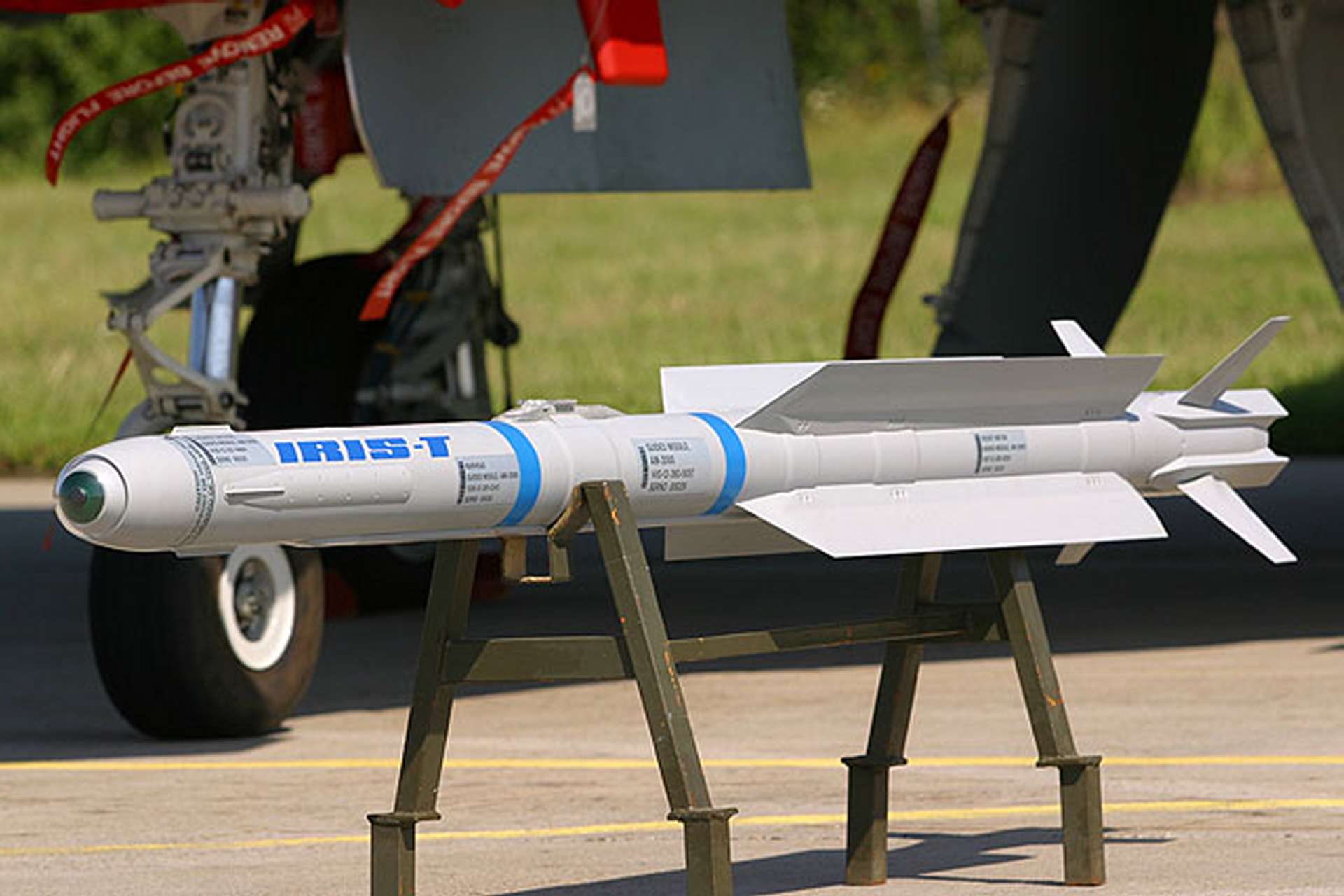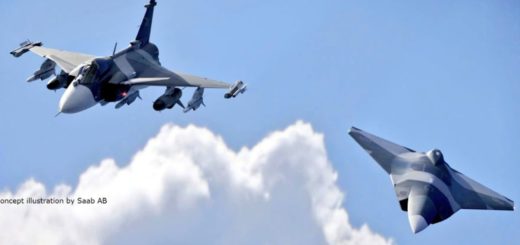Diehl Defence Signs IRIS-T Short Range Air-to-Air Missile Support Contract with Thailand

{loadposition bannertop}
{loadposition sidebarpub}
On October 16, 2024, Diehl Defence announced the signing of a support contract with the Royal Thai Air Force (RTAF) aimed at improving the operational capacity and use of IRIS-T short-range air-to-air missiles for its combat platforms. This contract marks a new step in the long and successful collaboration between both parties regarding the use of Diehl Defence’s IRIS-T missiles on RTAF aircraft.Follow Army Recognition on Google News at this link
Diehl Defence IRIS-T Short Range Air-to-Air Missile (Picture source: Wikimedia)
Currently, the RTAF operates Gripen, F-16, and F-5 fighter jets, all equipped with Diehl Defence’s IRIS-T missiles. The new contract, signed in Germany in early October, aims to enhance the RTAF’s capability to operate the IRIS-T missile across its entire fleet. It includes integration support, technical logistics support, and live firing assistance.
By signing this agreement, the RTAF once again demonstrates its exceptional ability to integrate and certify new weapons into its existing fleet, following the successful integration of the IRIS-T missile into its F-5 TH aircraft.
For Diehl Defence, this agreement represents another milestone in strengthening cooperation with the RTAF and expanding the use of the IRIS-T to additional platforms. The IRIS-T, a fifth-generation missile, is already integrated into Eurofighter Typhoon, Gripen, F-16, EF-18, F-5, and Tornado aircraft. Currently, the integration of the IRIS-T missile into the Korea Aerospace Industries (KAI) KF-21 fighter jet is ongoing.
The IRIS-T (InfraRed Imaging System Tail/Thrust Vector-Controlled) air-to-air missile is a fifth-generation short-range missile with high maneuverability due to its thrust vector control. It is equipped with a high-resolution infrared seeker capable of detecting and tracking targets with great precision, even under intense jamming conditions. With a maximum range of approximately 25 km and a speed of Mach 3, the IRIS-T can engage aerial targets from various angles, including the rear hemisphere, making it highly effective against advanced countermeasure maneuvers.
Introduced in 2005, the IRIS-T (InfraRed Imaging System Tail/Thrust Vector-Controlled) is a medium-range air-to-air missile developed through a cooperative program involving several European countries, including Germany, Greece, Italy, Norway, Sweden, and Spain. This program aimed to create a new missile system to replace older models like the AIM-9 Sidewinder. The IRIS-T has been designed for use in air-to-air engagements as well as for ground defense roles.
A key feature of the IRIS-T is its agility, attributed to a combination of thrust vectoring and aerodynamic control. This feature allows the missile to engage targets at various positions relative to the launching aircraft. The IRIS-T is equipped with an imaging infrared seeker head, which is integrated with image processing technology, intended to improve target acquisition and tracking. Target designation can be achieved through airborne radar or via the pilot’s helmet sight, offering flexibility in different combat situations. The missile is compatible with several types of fighter aircraft, such as the Eurofighter, F-16, EF-18, Tornado, and Gripen.
In addition to its air-to-air role, the IRIS-T has been adapted for surface-launched operations, like the IRIS-T SLS (Surface Launched System), which is designed for short-range defense. In 2016, the Norwegian Air Force tested the IRIS-T in a maritime role, indicating its utility in various domains.
Primarily manufactured by the German company Diehl Defence, the IRIS-T weighs 87.4 kg and is 2.94 m long with a diameter of 127 mm and a wingspan of 447 mm. The missile is equipped with a high-explosive/fragmentation warhead, detonated by impact, and an active radar proximity fuse. It is powered by a solid-fuel rocket and has an operational range of up to 25 km, capable of flying at altitudes from sea level to 20,000 m (66,000 ft) and reaching a maximum speed of Mach 3. The IRIS-T’s guidance system primarily uses infrared homing, with the IRIS-T SLX variant incorporating radar homing.
Thailand has a well-funded military and one of the best-equipped and trained air forces in Southeast Asia. Faced with an increasingly unstable regional security environment, the Royal Thai Armed Forces are placing greater emphasis on deterring external threats. They also play a significant role in internal security, particularly in the southern part of the country, where a Malay nationalist insurgency persists, albeit at a relatively low level. The Vision 2026 modernization plan, approved by the Defence Council in October 2017, outlines the planned capability improvements for the armed forces through the mid-2020s. The United States classifies Thailand as a major non-NATO ally, but Bangkok has also strengthened its defense ties with China since 2014. The armed forces regularly participate in international military exercises, notably the annual multinational Cobra Gold series with the US and some of its allies and partners.
Currently, the Royal Thai Air Force (RTAF) operates several fighter and ground-attack squadrons. It has two squadrons equipped with F-5E/F Tiger II fighters and three squadrons of F-16A/B Fighting Falcons. Additionally, one squadron is equipped with Gripen C/D aircraft, capable of conducting both air combat and ground-attack missions. These aircraft provide the RTAF with considerable operational flexibility, allowing it to respond to a wide range of missions, from air defense to strategic attack.

{loadposition bannertop}
{loadposition sidebarpub}
On October 16, 2024, Diehl Defence announced the signing of a support contract with the Royal Thai Air Force (RTAF) aimed at improving the operational capacity and use of IRIS-T short-range air-to-air missiles for its combat platforms. This contract marks a new step in the long and successful collaboration between both parties regarding the use of Diehl Defence’s IRIS-T missiles on RTAF aircraft.
Follow Army Recognition on Google News at this link
Diehl Defence IRIS-T Short Range Air-to-Air Missile (Picture source: Wikimedia)
Currently, the RTAF operates Gripen, F-16, and F-5 fighter jets, all equipped with Diehl Defence’s IRIS-T missiles. The new contract, signed in Germany in early October, aims to enhance the RTAF’s capability to operate the IRIS-T missile across its entire fleet. It includes integration support, technical logistics support, and live firing assistance.
By signing this agreement, the RTAF once again demonstrates its exceptional ability to integrate and certify new weapons into its existing fleet, following the successful integration of the IRIS-T missile into its F-5 TH aircraft.
For Diehl Defence, this agreement represents another milestone in strengthening cooperation with the RTAF and expanding the use of the IRIS-T to additional platforms. The IRIS-T, a fifth-generation missile, is already integrated into Eurofighter Typhoon, Gripen, F-16, EF-18, F-5, and Tornado aircraft. Currently, the integration of the IRIS-T missile into the Korea Aerospace Industries (KAI) KF-21 fighter jet is ongoing.
The IRIS-T (InfraRed Imaging System Tail/Thrust Vector-Controlled) air-to-air missile is a fifth-generation short-range missile with high maneuverability due to its thrust vector control. It is equipped with a high-resolution infrared seeker capable of detecting and tracking targets with great precision, even under intense jamming conditions. With a maximum range of approximately 25 km and a speed of Mach 3, the IRIS-T can engage aerial targets from various angles, including the rear hemisphere, making it highly effective against advanced countermeasure maneuvers.
Introduced in 2005, the IRIS-T (InfraRed Imaging System Tail/Thrust Vector-Controlled) is a medium-range air-to-air missile developed through a cooperative program involving several European countries, including Germany, Greece, Italy, Norway, Sweden, and Spain. This program aimed to create a new missile system to replace older models like the AIM-9 Sidewinder. The IRIS-T has been designed for use in air-to-air engagements as well as for ground defense roles.
A key feature of the IRIS-T is its agility, attributed to a combination of thrust vectoring and aerodynamic control. This feature allows the missile to engage targets at various positions relative to the launching aircraft. The IRIS-T is equipped with an imaging infrared seeker head, which is integrated with image processing technology, intended to improve target acquisition and tracking. Target designation can be achieved through airborne radar or via the pilot’s helmet sight, offering flexibility in different combat situations. The missile is compatible with several types of fighter aircraft, such as the Eurofighter, F-16, EF-18, Tornado, and Gripen.
In addition to its air-to-air role, the IRIS-T has been adapted for surface-launched operations, like the IRIS-T SLS (Surface Launched System), which is designed for short-range defense. In 2016, the Norwegian Air Force tested the IRIS-T in a maritime role, indicating its utility in various domains.
Primarily manufactured by the German company Diehl Defence, the IRIS-T weighs 87.4 kg and is 2.94 m long with a diameter of 127 mm and a wingspan of 447 mm. The missile is equipped with a high-explosive/fragmentation warhead, detonated by impact, and an active radar proximity fuse. It is powered by a solid-fuel rocket and has an operational range of up to 25 km, capable of flying at altitudes from sea level to 20,000 m (66,000 ft) and reaching a maximum speed of Mach 3. The IRIS-T’s guidance system primarily uses infrared homing, with the IRIS-T SLX variant incorporating radar homing.
Thailand has a well-funded military and one of the best-equipped and trained air forces in Southeast Asia. Faced with an increasingly unstable regional security environment, the Royal Thai Armed Forces are placing greater emphasis on deterring external threats. They also play a significant role in internal security, particularly in the southern part of the country, where a Malay nationalist insurgency persists, albeit at a relatively low level. The Vision 2026 modernization plan, approved by the Defence Council in October 2017, outlines the planned capability improvements for the armed forces through the mid-2020s. The United States classifies Thailand as a major non-NATO ally, but Bangkok has also strengthened its defense ties with China since 2014. The armed forces regularly participate in international military exercises, notably the annual multinational Cobra Gold series with the US and some of its allies and partners.
Currently, the Royal Thai Air Force (RTAF) operates several fighter and ground-attack squadrons. It has two squadrons equipped with F-5E/F Tiger II fighters and three squadrons of F-16A/B Fighting Falcons. Additionally, one squadron is equipped with Gripen C/D aircraft, capable of conducting both air combat and ground-attack missions. These aircraft provide the RTAF with considerable operational flexibility, allowing it to respond to a wide range of missions, from air defense to strategic attack.







